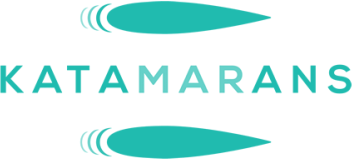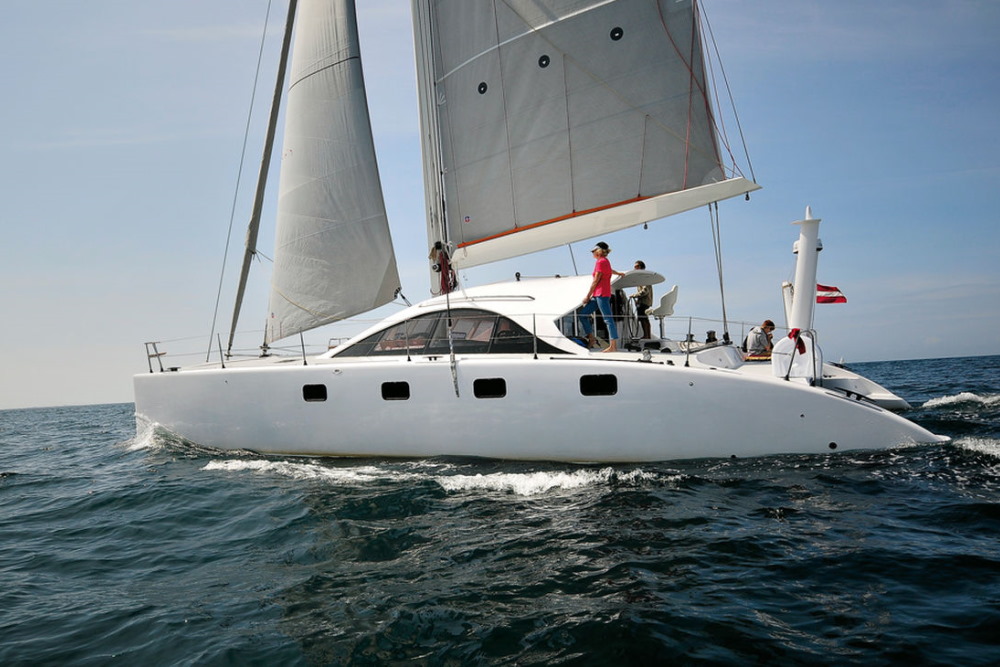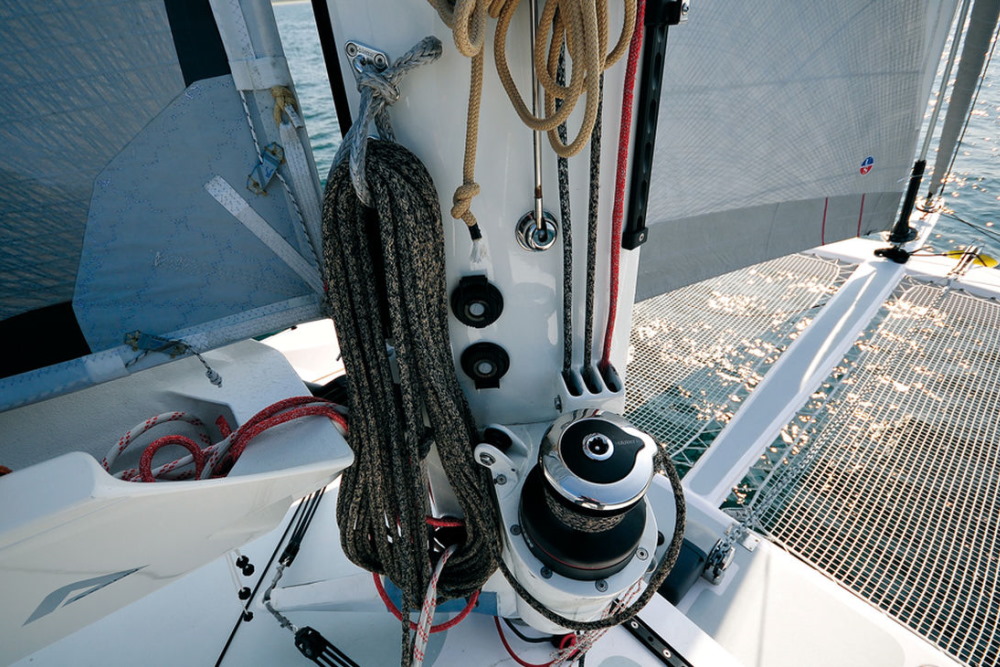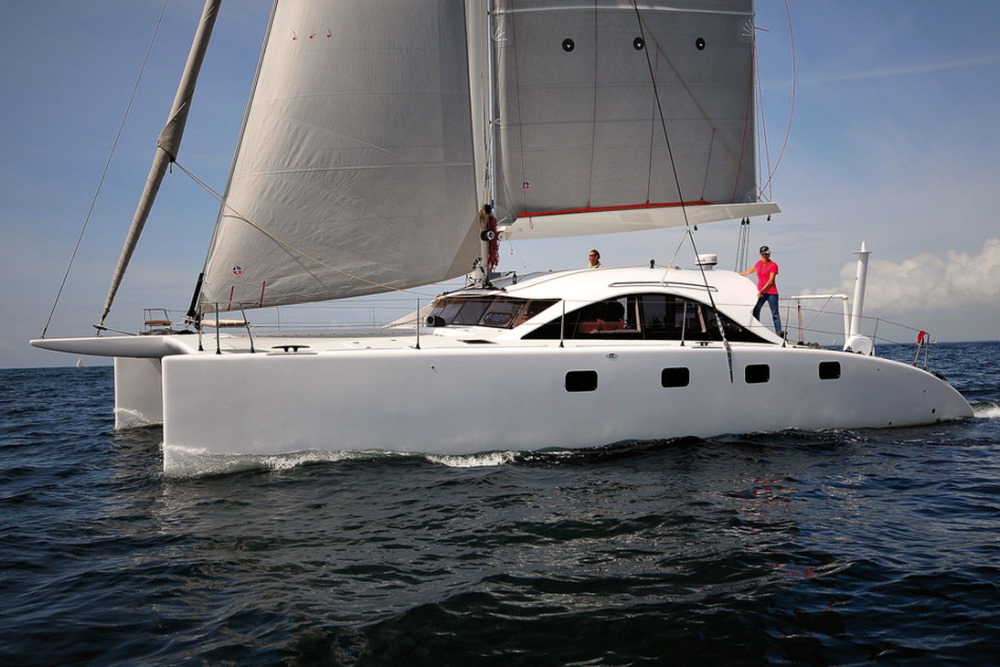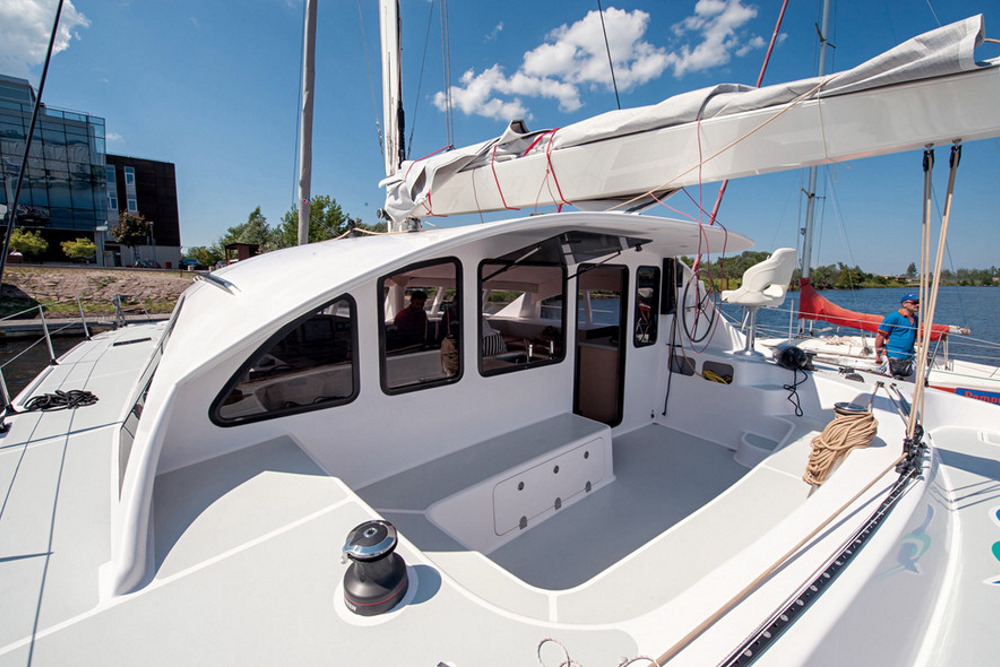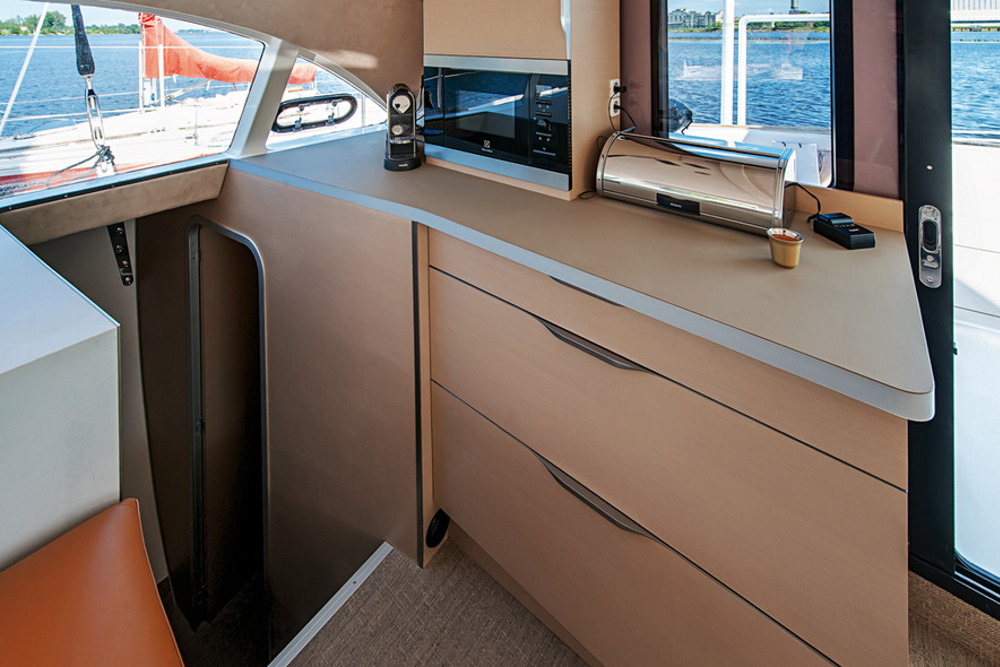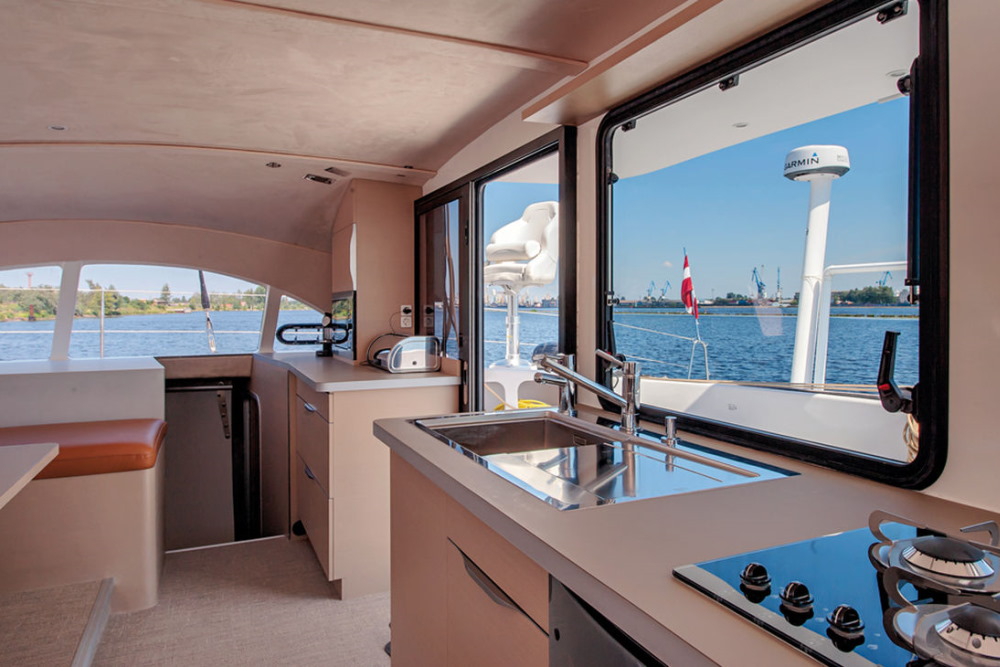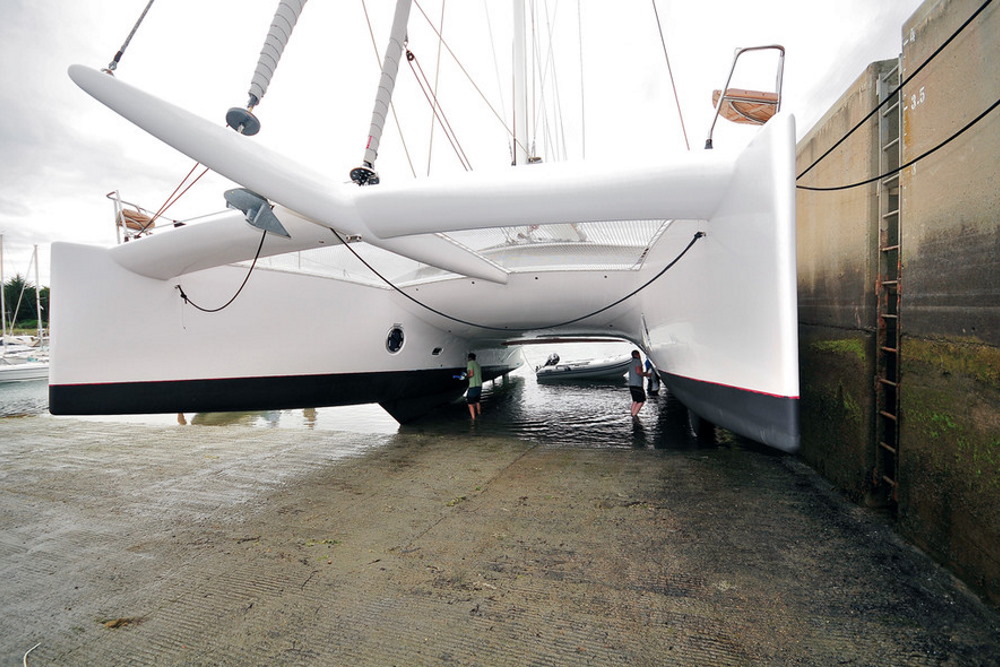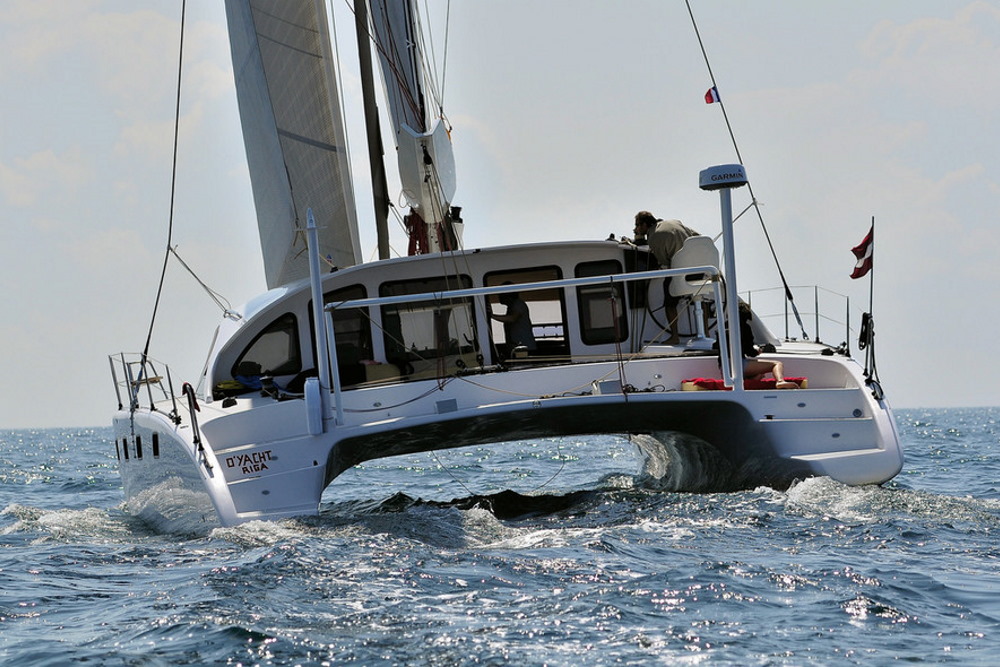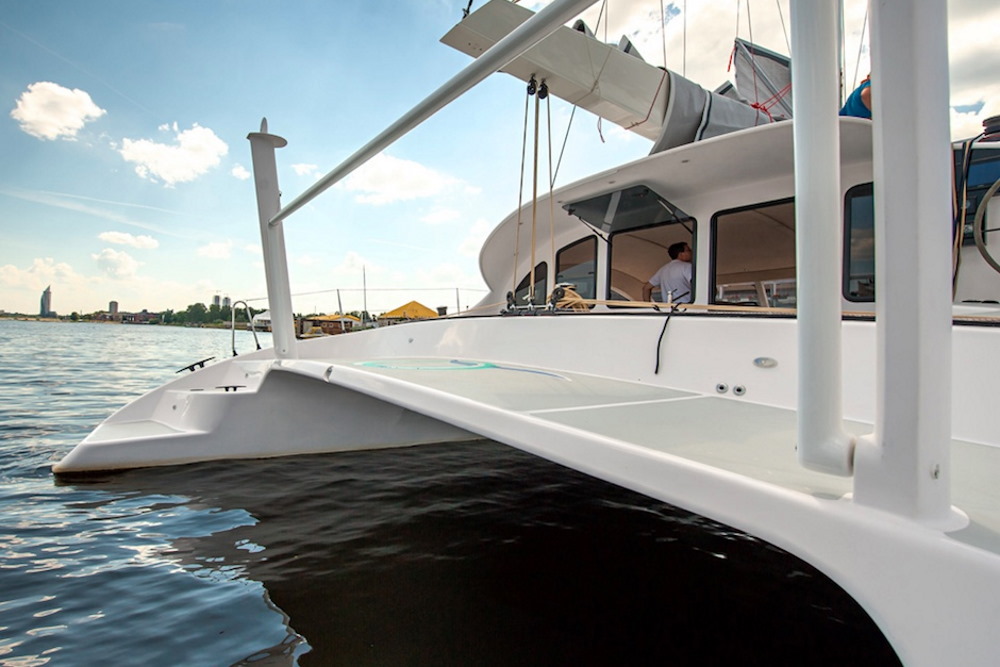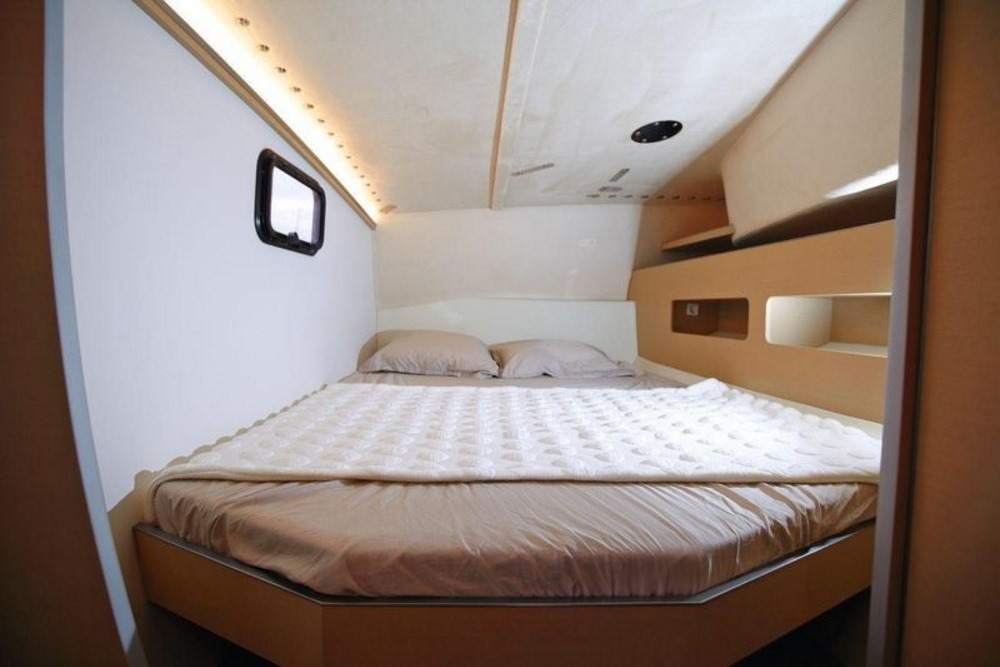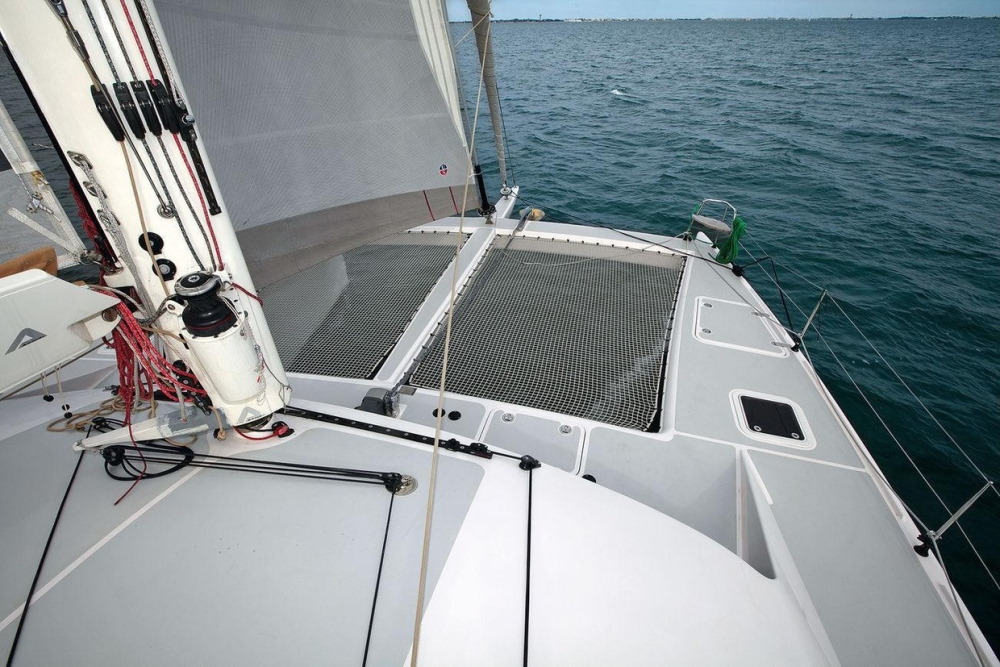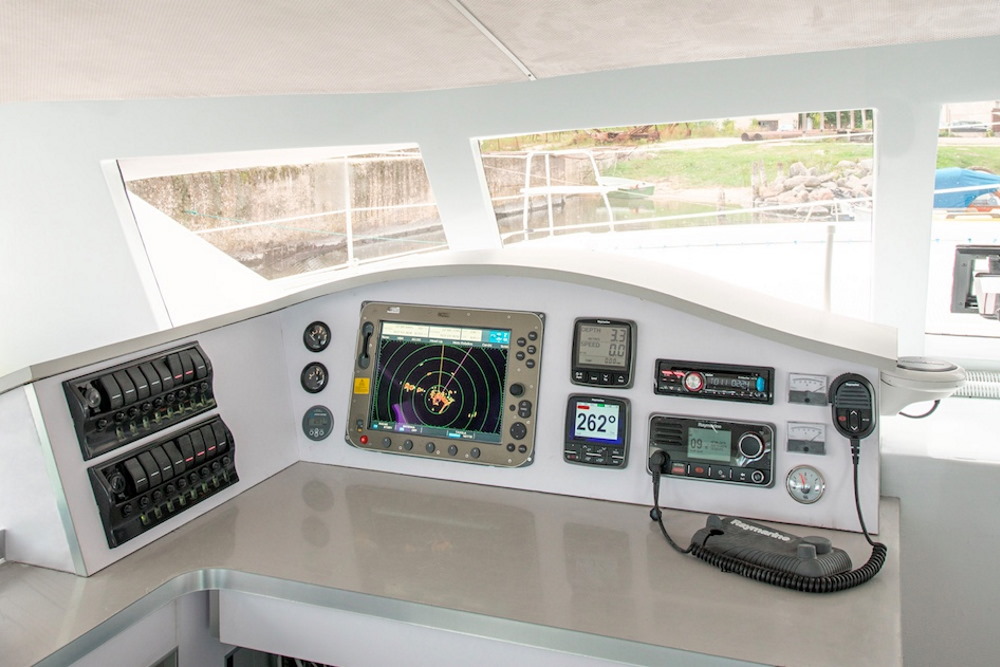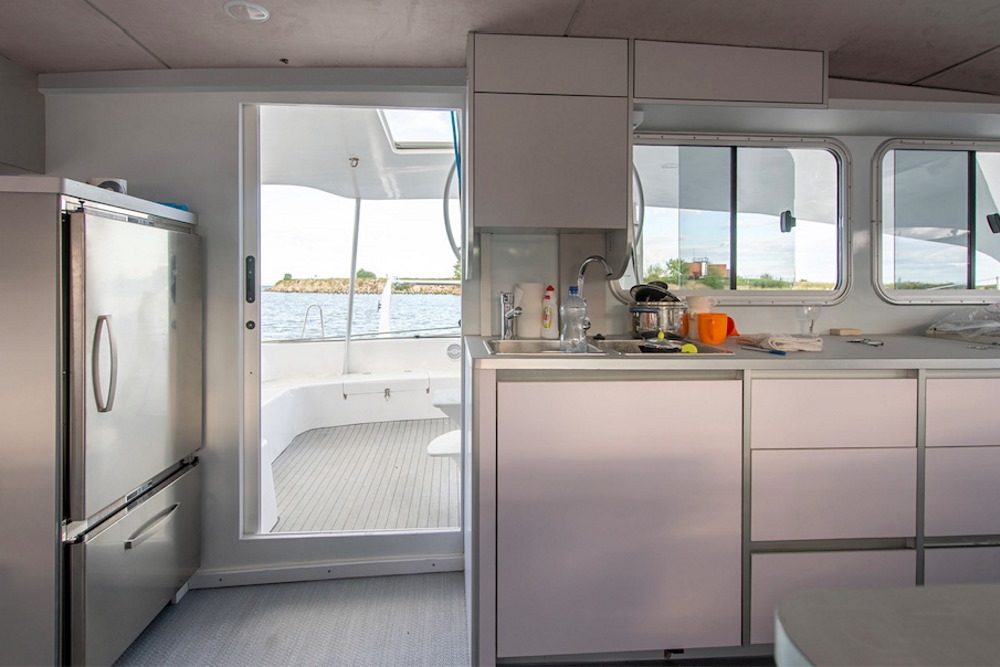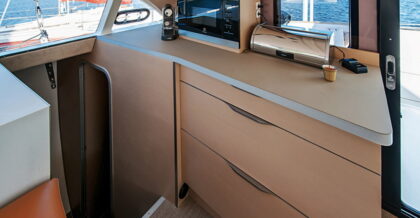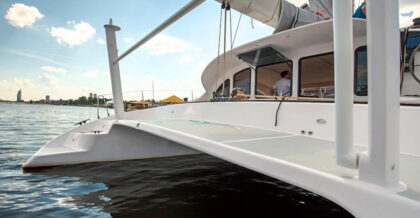O-Yachts Class 4
The O-Yachts Class 4 is the smaller sister to the Class 6, designed by Érik Lerouge and built in Latvia under the direction of Dan Levy. The forward profile is classic Lerouge with the bowsprit and curved forward beam in carbon, fine, straight bows, and a shapely nacelle.
Clifford Denn added his input in designing the rounded coachroof to minimise windage and the overall curved look of the saloon;
Lerouge Fast Cat
Érik Lerouge studied in Southampton in the seventies, and designed his first catamaran : Inoui, not long after. He has successfully raced his designs in events all over the world including Speed Weeks, Bol d’Or, Trophee des Multicoques, the MULTI 2000 Challenge, Transat des Alizes, and the Sydney Harbour 18 footers Worlds.
The Class 4 is semi-customisable and is available with keels (like the Nautitech 44 Open but faster) or daggerboards (like the Outremer 45 but lighter).
Daggerboards give you optimum performance upwind in light airs (another 5 degrees into wind), fixed keels are safer in the even of a collision under the water, and free up room down below without sacrificing too much performance, especially when the wind picks up. In over 15 kts of wind you won’t notice much difference in performance
Other options include a rotating mast (carbon), fixed carbon or fixed aluminium mast with different sail plans.
Érik Lerouge has done a fine job on the hydrodynamic shaping of the hulls: this is a quick boat. A class 4 was the first placed multihull in the 2014 ARC with a maximum logged speed of 27kts. This boat is about as far away as you can get from a Bali Catspace Sail or other production cruising catamarans. She competes against yachts like the Outremer 45 and is quite a bit lighter (7.5T versus 8.2T)
This area is worth some discussion, as it is one of the aspects of the Class 4 that differentiates it from the competition.
The nacelle, hulls, deck and coachroof are sandwich infused and laminated by hand, and are solidly assembled. A layer of Kevlar is used to strengthen the underwater sections. Forward beam, main bulkhead, compression beam and bowsprit are all built in carbon fiber, making a stiff, light structure. Everything up front is hand laminated to optimise strength and rigidity in this area.
With a 7.2T light displacement, the Class 4 is one of the lightest bluewater sailing catamarans on the market: a real sailing machine, with safety at sea a key part of the philosophy.
Carbon is used as standard on the front beam, bowsprit, mast support, mast beam.
They also add a Kevlar shield (center to peak / 8inch over water line).
Carbon Forward beam / Bowsprit
Erik LEROUGE insisted on a complete carbon beam connection between the hulls and the central link to the boat. On most catamrans, the forward beam is a bolted 7 inch tube. On the Class 4, you have 28 Layers of carbon linking to the hull side and another 28 layers of carbon from bow pole to platform along the trampoline center. This helps to give the boat its high rigidity and low weight.
Hand lamination on infused panels
All non structural panels also help with the rigity (sofa, stairs, floors, kitchen, cabinets). The panels are first built on an infusion table and are then hand laminated before fairing/sanding to make the Class 4 as solid as a rock.
The key point here is that O-Yachts are unique in this market segment in offering a carbon reinforced structure as standard. Carbon is used for the front and central beams, bowsprit, mast support and beam, and aft beam. As standard, they also use kevlar as a shield on hull.
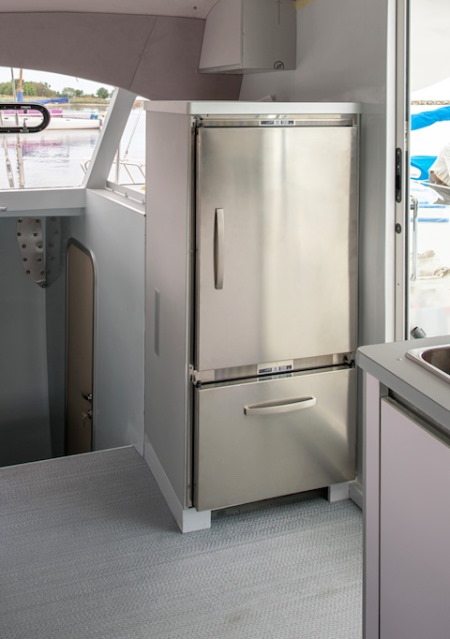
The overall feel is one of Baltic simplicity.
The saloon is very comfortable (4.5m by 3.15m) with plenty of space for cooking, navigating and lounging: the furniture is constructed in sandwich with aluminum trim and a quality finish.
The room inside is somewhere between an Outremer 45 and a 51.
The nav station faces forwards to port and looks very business like.
Semi-Custom
There are custom options available for the saloon door (large central or side sliding door), the layout of the saloon and the bimini (long or short).
Down below, both aft cabins have large berths (1.40m/1.60m x 2m).
The other unique design feature to the Class 4 is the aft platform (4.5m x 1.1m).
While this does reduce the area of the aft cockpit, it means that you can hoist your dinghy safely onto the boat while under way and it doubles up as a sunbathing area / diving platform while at anchor.
Traditional davits are also an option for the tender.
Carbon Davits Option
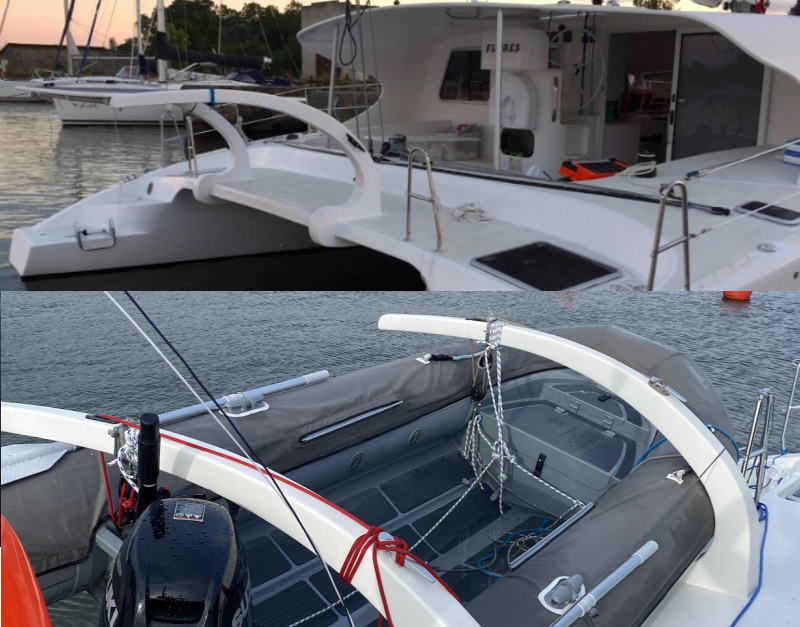
A nice touch on the carbon davits is that they have been designed to tuck your tender into so that it is really secure under way
Sailing
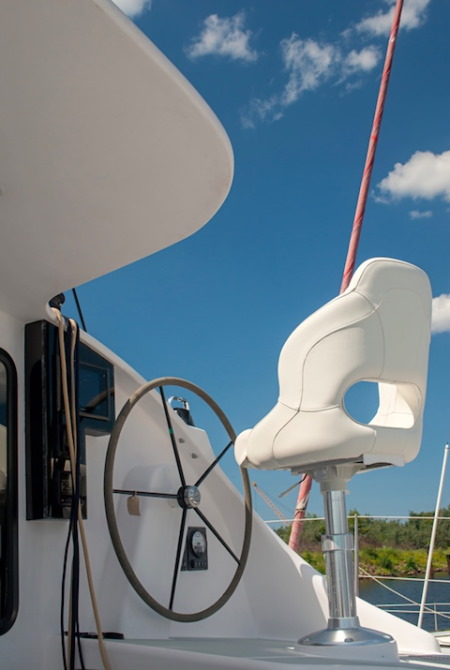
The O-Yachts Class 4 is a sailor’s boat: simplicity and ease of use is the order of the day here. Owners can opt for a single helm or twin helms at the main bulkhead position with a single or twin seat. The main design driver behind O-Yachts is safety first (considerable performance follows).
These boats are strong and very rigid and the systems have been set up for easy management by a couple.
An Efficient Design
The halyards and reefing lines are tidily managed at the mast with two winches, one being electric. Friction on the lines is minimised: although you will need to leave the cockpit to shorten sail, this set up means that you are able to lock the lines close to the action. This is Form Follows Function design.
There are 2 options for the mainsail, with a bigger Premium version available for owners looking for higher performance. The baot is powered up front with a self tacking-solent and an overlapping genoa that flies off the bowsprit. These should power you along at true wind speeds and even above.
The sail plan is traditional, but there are also plenty of options for flying lighter sails from the bowsprit. A carbon Axon rotating mast option boosts the power with a larger square-topped mainsail and along with fiber shrouds and high quality fittings, the whole package is one of an over engineered design with that trademark of Lerouge designs: low windage and high rigidity
That rotating mast (an option) also makes it easier to reef just off the wind with the solent semi-powered by the way.
In light winds, this boat is designed to sail faster than the wind from 3 to 9kts, so you should be sailing more and motoring less. When the wind is blowing from 10 to 15kts, you will be cruising over 10kts, and in 20-25kts, you will be sailing from 14 to 19kts with shortened sail.
Options include a cruising aluminium mast, a performance fixed carbon mast and a race rotating carbon mast.
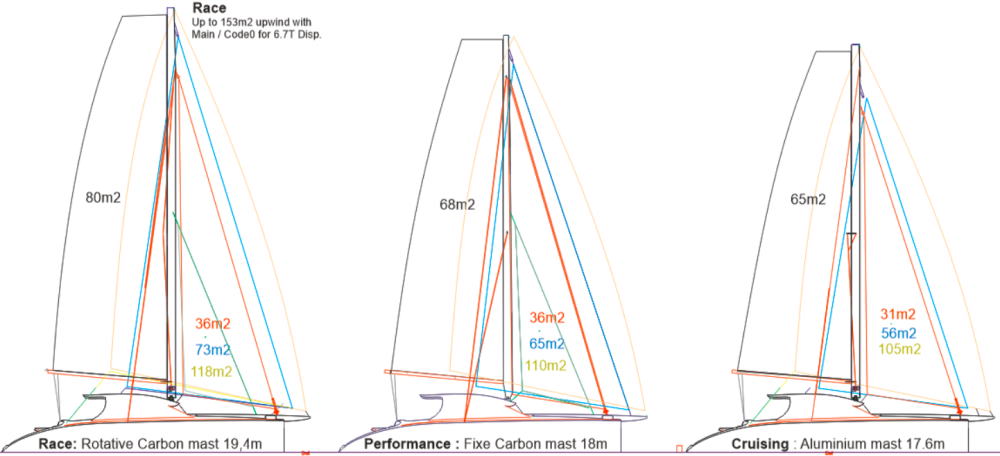
Cockpit
Heading aft, the cockpit feels very safe with it’s wrap around bench. There are options for a full bimini to maximise protection or a shortened version for those who like the maximum view of the sails. There’s a fixed table that seats 8 to port with a large opening window to connect to the galley. The area to starboard has been kept clear (Dan calls this the dancefloor) and the most popular helm position is just a short hop up in the main bulkhead poistion starboard.
There are 3 options on the Class 4:
- 100% Diesel : 2 Yanmar 30hp on saildrive.
- Smart Hybrid : 1 Yanmar 30hp on saildrive + 1 electric engine (10 or 15kW).
- 100% Electric: 2 electric engines from 10 to 15kW. With a Diesel 48V generator for safety.
With the diesels, you should hit 7kts cruising on 1 engine in a good sea state.
Electric Power
Two Class 4s have already been configured with electric 10kW Ocean Volt engines that push the boat along at 6kts with 6kW in good conditions with one engine. The OceanVolt engines have a “ServoProp” solution for regeneration. The self pitch propeller is also 10 to 15% more efficient when motoring.
There are also options for more advanced solutions such as retractable pods with RIM BlueNav engines that rotate 360°.
The O-Yachts Class 4 is a 45 foot catamaran designed for safety at speed by one of the legends of multihull design: Erik Lerouge, and built under the direction of Dan Levy: a fanatic on the details. With her semi-carbon construction as standard, this is a well organised, strong and rigid catamaran that gives you plenty of bang for your buck. The target on this yacht is 250 safe mile days in good conditions, in the same bracket as a Fusion 40 catamaran or a Schionning but with a more robust construction.
You can find further information at O-Yachts.
| Draft | 1.1m / 3.6′ |
|---|---|
| D/L | 68 |
| Mainsail | 65m2 / 700sq ft |
| Power | 2x 30HP Yanmar |
| Water | 300L / 79 US gal |
| Fuel | 400L / 106 US gal |
| Genoa | 56m2 / 603sqft |
| Length | 13.99m / 46′ |
| Beam | 7.6m / 24.9′ |
| Gennaker | 105m2 / 1130sqft |
| Mast | 17.6-19.4m / 57.7-63.6′ |
| Jib | 31m2 / 333sqft |
| Max Displ | 9.4T / 19,400 lbs |
| Headroom Saloon | 2.1m / 6.9′ |
| Light Dsipl. | 7.2 T / 15,873 lbs |
| Pack | Cruising |
| SA/D (Cruise) | 25.5 |
| Other Packs | Performance / Race |
Contact Katamarans
Share your details with us and we’ll be in touch to discuss further.
"*" indicates required fields
